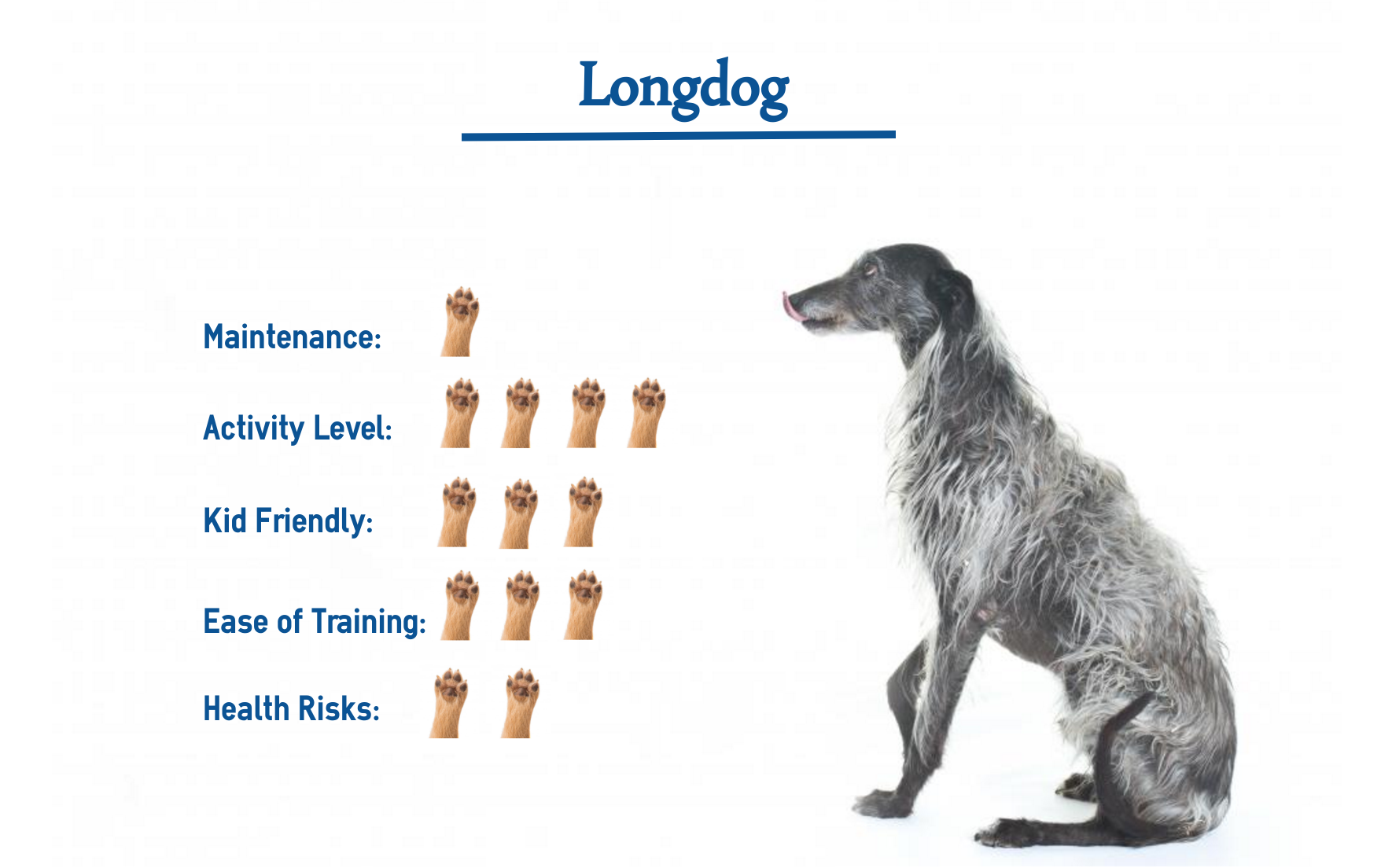If you’ve either never heard of a “Longdog” before or if your first instinct is to think of a Dachshund or “wiener dog” when someone mentions the name “Longdog,” don’t fret because you’re not alone. Many folks initially think of this when they hear the word “Longdog.” This is why we wanted to take a moment and discuss exactly what a Long Dog is and point out how this dog breed differs from others, which may seem very similar.
So, without further ado, let’s dive right in.
Longdog Fast Facts
Country of Origin: Ireland
Original Purpose: Hunting
Breed Group: Mixes and More
Height: 24 to 30 inches at the shoulder
Weight: 35 to 100 pounds
Dog Breed Classification: Not officially recognized by the American Kennel Club (AKC), but given its lineage, one would assume “hound group.”
Life Span: 10 to 13 years
Origin of the Longdog
The Longdog has its origins in Ireland. People have been crossing dogs for more than 2,000 years now. The Egyptians did it, as did the Romans and the Greeks, and the Longdog is simply one more example of this. The Longdog is one of the crossbreeds that have become a hit with dog owners over the last few decades. But it is hard to give an exact date when they were first bred.
Mainly because these dogs were bred for coursing, a big sport in many parts of the world, and not really for “show.” This means their “creation” happened on the “fly” and isn’t well documented.
Now, at this point…
It probably makes sense to define precisely what “coursing” is because coursing involves setting sighthounds, such as greyhounds, on game animals, such as hares. Over the last few centuries, there has been a significant demand for fast sighthounds capable of hunting the hare at 72 km/h. That led to crossbreeding sighthounds, such as Greyhounds, with the Scottish Deerhound, Saluki, and Whippet.
And that was how the breed standard for the Longdog was created. This crossbreed is not recognized by the American Kennel Club today.
Comparisons: Longdogs vs. Lurchers
Longdogs are often compared to Lurchers. Lurchers and Longdogs have the same lean, mean, and hungry look but differ. A longdog is a cross between two sighthounds, while a Lurcher is between a sighthound and a working dog. But it should be pointed out that Longdogs are much faster than Lurchers. But at least with Lurchers, you have a chance of catching up. With Longdogs – No chance!
They are perhaps the most athletic dogs, swift and blessed with incredible stamina. A Longdog can run for miles at top speed without stopping.
Physical Characteristics of the Longdog
Longdogs are very tall, reaching a height of 24 to 30 inches. They are not that heavy. They weigh in the range of 35 to 100 pounds. They are similar to Greyhounds in a lot of ways. Like a typical hound, these crossbreeds have muscular bodies, deep chests, and arched backs. They have a tiny, arrow heabodiesong muzzle, bright eyes, and small, folded ears. Longdogs also have long, muscular necks and legs, with well-bent back knees and hocks. They have a smooth and short coat in many different textures and colors.
Now you…
You won’t need to spend much time or energy grooming the long. It should be enough to give his coat a good brush once a week to remove the dead hair. Also, it is essential to trim his nails and clean his ears to prevent infections.
Temperament and Personality
The temperament of a Longdog is not much different from that of a Greyhound. The Greyhound is one of the most ancient breeds that has been around for thousands of years. Like the Greyhound, the Longdog breed is calm, composed, kind, and generous with his human family. He is relaxed and laid back by nature. But he is almost like a predator on the prowl when he goes on a hunt. There is no stopping him from getting to his target.
Longdog is also…
He is very tolerant of children but not precisely a playmate for kids like some other dog breeds. He doesn’t like cats, though, and is likely to see cats as food more than anything else. He doesn’t like other pets but can get along well with other dogs.
Potential Health Concerns
Longdog is a healthy breed for the most part. It is rare for a Longdog to get sick. But if your dog doesn’t feel too good or looks more lethargic or quieter than usual, you should take him to a vet.
While the Longdog is a healthy breed, it does pick up a few health disorders from its parents, such as…
- Dermatitis,
- Liver Cancer,
- Gastric dilatation volvulus (Bloat),
- Cardiomyopathy,
- Achalasia,
- Osteosarcoma,
- Anesthetic Intolerance.
While many of these conditions may not be life-threatening, they can become quite expensive, particularly if they become. In particular, we here at IndulgeYourPet also recommend that any new pet owner take a moment and see what it might cost for you to purchase a pet insurance policy for your new animal.
Now, will a pet insurance policy be suitable for everyone?
No, probably not. But until you fully understand what these policies “will” and “won’t” cover and how much these pet insurance policies cost, how will you know if one might be right for you?
For more information on who we feel currently offers the “best” pet insurance policies out there, we would encourage you to check out our Best Pet Insurance Policies article.



